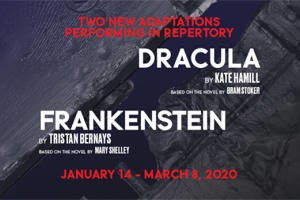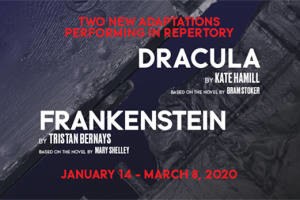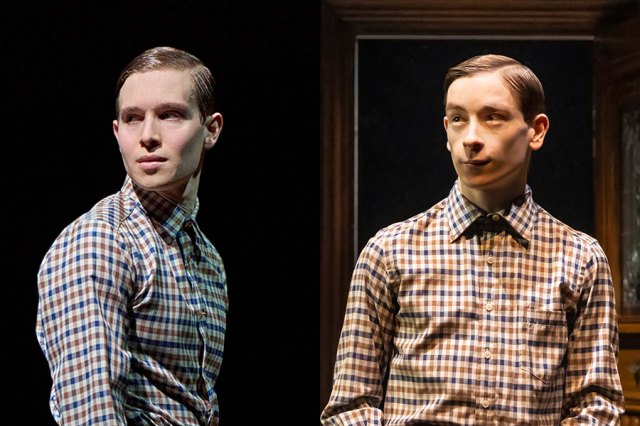Tristan Bernays and Kate Hamill on Finding New Modern-Day Meaning in Gothic Horror
While adapting ”Dracula” and ”Frankenstein” for the stage, the playwrights reflect on the monsters of everyday life.
Mary Shelley's Frankenstein and Bram Stoker's Dracula share much in common. Their titles are often uttered in the same breath, both are considered classic works of Gothic horror, and each has inspired seemingly countless adaptations for stage and screen.
Their sweeping tales of horror and adventure have attracted audiences for decades, both on Broadway and off, and two radically new adaptations are currently in performances downtown. Kate Hamill, known for her innovative contemporary adaptations of classic texts, has fashioned Dracula into a "feminist revenge fantasy," partially driven by her desire to write a female buddy comedy along the line of Ghostbusters, while Tristan Bernays' two-hander Frankenstein was first crafted for young audiences in English schools.
Minimalism is embodied in both productions. Props include a bed, a table, some buckets and a few instruments, no blood is shed and Frankenstein's creature does not wear makeup. But there's no shortage of horror – both supernatural and real-life.

(photos provided by Blake Zidell and Associate)
These are complicated texts to adapt. Frankenstein is more than 200 pages, and Dracula is twice that length. Frankenstein is told through flashbacks, while Dracula is crafted in epistolary format. How did you approach adapting these epic stories?
Tristan Bernays: I love the book [Frankenstein] but am also aware of problems with the book. I think it's a good book and an incredible myth, which itself is more precious than making a story. Myths transcend time and space and culture. People understand what myths are, even if they haven't read the source material.
When you read the book, the best thing in it is the Creature. The Creature is the most interesting, most moving, has the best lines, so my thought was, "Why don't we just start with the Creature? He's the main focus. Let's start with him learning to talk and walk." It's quite fun, it's quite playful, and it makes the audience pay attention.
Kate Hamill: It's a very radical departure from the novel [Dracula]. I was very interested in vampires that look just like us. I was particularly interested in looking at it through the lens of reacting against traditional Dracula adaptations but also… looking at it how even in the 1900s, marriage was this institution where you were giving all your power to the man. And I think any time a ruling group has too much power, they're going to abuse it. Especially the way the vampires getcha in this particular play – with an offer of power. I think that's why both men and women fall for the patriarchy, because you think you'll have some sort of power or protection – power by proxy – and the truth is it just sort of makes you a servant.
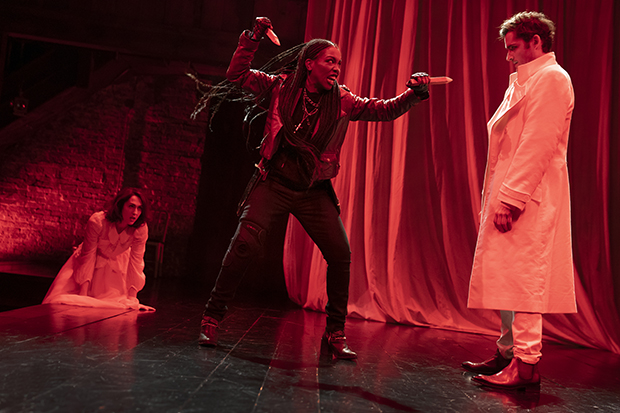
(© Joan Marcus)
These novels are hundreds of years old but their themes feel especially relevant to present-day audiences. Tell me about your thought processes when you decided which aspects of the stories to embody onstage.
Tristan: I try to not [deliberately make plays political] because I don't like didactic theater. I like theater that tells a good story. I think the interesting thing is the audience brings what they want to it. My theory was it's a good story, it's got a monster, and blood and guts and chases and big drama, so just lean into that and tell the story well. All the themes are there if you want them. For me, a big theme is parental responsibility. There's also technology, there's race, depending on how it's played.
Kate: My experience of the patriarchy and toxic men – and Dracula in this is very much a toxic man – is that they're deceptive. You think you'll be able to identify them at a glance, but they're extremely good at camouflaging themselves. Because I was interested in vampirism as a metaphor for toxic masculinity, I was interested in how men and women get sucked into that. This is vampirism as a kind of parasitism.
I was interested in if vampires are people who are making you feel like you're making an autonomous choice but you're playing into their systems. Every single character in this play who's a woman, certainly and the men, too, is really struggling with autonomous choice.
Tristan, with Stephanie Berry, a woman of color, playing the Creature, the play could be seen as an allegory regarding racism. And Kate, it was difficult to not think about Harvey Weinstein when watching Dracula. Did you lean into these aspects of the shows, or did they evolve naturally?
Tristan: The production brings that to it with casting a black female lead as the Creature. The audience brings that as well. There's a lot here about race. I saw that as well. I think that's what's great about seeing someone else take your script and do something with it. Each time they do something different and find something you never intended.
[A theme of racism was] not written in the piece at all. The show was originally performed by a tall, skinny 23-year-old white guy. When I met [director] Timothy [Douglas] online and we were chatting on Skype about the show, he had the idea of doing it as an older black actor and a woman. He asked, "What do you think?" and I said, "Sounds great. No reason why you couldn't at all." Again it's just storytelling. None of it is real, so why not do that?
Kate: I can't tell you at this point in time how satisfying it is to have a play where we stake a toxic man in the heart while shouting, "No, no, we said no!" This story has been done in a lot of problematic ways, so it's an attempt to strike back.
I think the deception of Dracula in this piece is he seems to offer an alternative, but the problem is it's very consume or be consumed. If you fall for sort of the patriarchy structures, you just become further enmeshed. They don't get empowered. They just become forever servants. There is something Weinstein-esque there. I had to make Dracula not completely repulsive because you have to understand some of the draw.
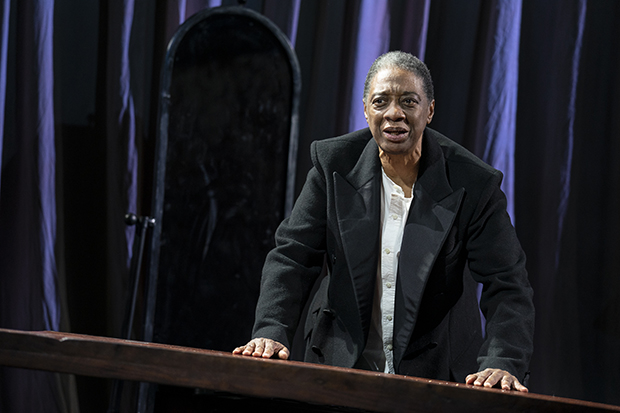
(© Joan Marcus)
What is it about Dracula and Frankenstein that keeps drawing people back over the years?
Tristan: Dracula is called Dracula but it's actually about the people, and Frankenstein is called Frankenstein but actually about the monster. What keeps you coming back is the idea of what these monsters represent. How many headlines have you seen about GM food, people call Frankenstein farming? People understand what Frankenstein is – a scientist who's out of control. Or the idea of Dracula, who infects all aspects of popular culture. I think you love the stories because of the monsters. They are about boogeymen and monsters and what they represent.
Kate: Monsters tell us about ourselves and our shadow desires and shadow fears. Our monsters tell us about ourselves. I think the lie of it is that we ever escape monsters because I don't think we do. That's why we have to be really careful when we are making our stories. I think who our heroes are and who our monsters are and what we say about them really shape our perceptions of the world, whether or not we realize it.


